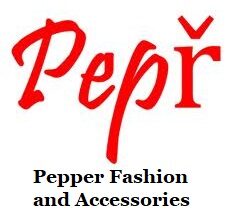Contents [hide]
- 1 A Guide to Choosing the Best Nursing Bra
- 1.1 Congratulations on your New Journey into Motherhood!
- 1.2 Why a Nursing Bra is Essential for New Mums
- 1.3 Benefits of Wearing a Nursing Bra
- 1.4 Understanding the Different Types of Nursing Bras
- 1.5 Factors to Consider when Choosing a Nursing Bra
- 1.6 Sizing and Fitting Tips for Nursing Bras
- 1.7 Features to Look for in a Nursing Bra
- 1.8 How to Care for your Nursing Bra
- 1.9 Common Misconceptions about Nursing Bras
- 1.10 Conclusion: Find the Best Nursing Bra
- 1.11 Pregnancy and Nursing Care
- 1.12 Women's Plus-Size Lingerie
- 1.13 How to Choose Comfortable and Sexy Women's Lingerie
A Guide to Choosing the Best Nursing Bra
Congratulations on your New Journey into Motherhood!
Listen to the Audio “A Guide to Choosing the Best Nursing Bra”
Audio Player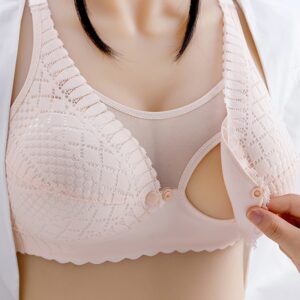
As a new mom, it’s essential to find a nursing bra that not only provides comfort and support but also makes breastfeeding a breeze. With so many options available, it can be overwhelming to choose the perfect pepper nursing bra that meets all your needs. That’s why we’ve created the ultimate guide to help you navigate through the world of nursing bras and make an informed decision.
In this comprehensive guide, we’ll walk you through the key factors to consider, such as fit, style, functionality, and durability. We’ll also discuss the benefits of using a pepper nursing bra and provide helpful tips to ensure a comfortable and successful breastfeeding experience.
Whether you’re a first-time mom or looking to upgrade your existing nursing bra, this guide will be your go-to resource for finding the perfect pepper nursing bra that combines style, comfort, and functionality.
So, let’s dive in and find the perfect bra that will support you in this beautiful and transformative journey of motherhood.
Why a Nursing Bra is Essential for New Mums
As a new mum, you may wonder why a nursing bra is necessary when you already have a collection of regular bras. Here are a few compelling reasons why investing in a nursing bra is essential:
-
- Easy access for breastfeeding: Nursing bras are designed with easy-to-open flaps or clasps that allow quick and discreet access for breastfeeding. This feature eliminates the need to remove or adjust your bra, making the feeding process more convenient for both you and your baby.
- Comfort and support: Nursing bras are specifically designed to provide optimal comfort and support during breastfeeding. They are made from soft, stretchy fabrics that accommodate the changes in your breast size and shape. The additional support in the form of wider straps and reinforced cups helps alleviate the strain on your shoulders and back.
- Prevention of milk leakage: Nursing bras often come with built-in pads or pockets to accommodate nursing pads. These pads help absorb any milk leakage, preventing embarrassing stains on your clothing.
- Enhances milk flow: Optimal breast support provided by nursing bras can enhance milk flow and prevent clogged ducts, ensuring a smooth and successful breastfeeding experience.
Benefits of Wearing a Nursing Bra
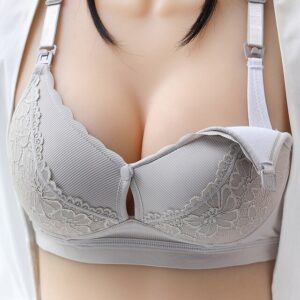
Apart from the convenience and comfort they offer, nursing bras come with a range of benefits that can significantly enhance your breastfeeding journey. Here are some key advantages of wearing a nursing bra:
-
- Promotes lactation: The right nursing bra, with its proper support and fit, can help promote lactation by ensuring that your breasts are well-supported and free from restrictions. This promotes healthy milk production and flow.
- Prevents sagging: Pregnancy and breastfeeding can take a toll on the elasticity and shape of your breasts. A well-fitted nursing bra provides the necessary support to minimize sagging and maintain the natural shape of your breasts.
- Reduces discomfort: Engorged breasts, sore nipples, and milk leakage are common discomforts experienced by new mums. A nursing bra, designed with soft and breathable fabrics, can help alleviate these discomforts and provide relief.
- Boosts confidence: Feeling comfortable and confident while breastfeeding is crucial for a positive nursing experience. Nursing bras that combine style with functionality can help boost your confidence, allowing you to breastfeed anywhere and anytime without hesitation.
Understanding the Different Types of Nursing Bras
When it comes to nursing bras, there are several types to choose from, each catering to different needs and preferences. Here are the most common types of nursing bras:
-
- Maternity bras: Maternity bras are designed to be worn during pregnancy and can also be used for breastfeeding. They provide comfort and support for growing breasts and often have adjustable features to accommodate changing breast size.
- Sleep bras: Sleep bras are specifically designed to be worn during sleep or lounging. They are made from soft, stretchy fabrics and provide gentle support and easy access for night-time feedings.
- Seamless bras: Seamless bras are a popular choice among new mums due to their smooth and comfortable design. They have no seams or underwires, making them ideal for sensitive breasts and offering a seamless look under clothing.
- Underwire bras: Underwire nursing bras provide additional support and lift. They are designed with a flexible underwire that supports the breasts while still allowing easy access for breastfeeding. It’s important to ensure a proper fit and choose an underwire bra specifically designed for nursing to avoid discomfort or clogged ducts.
- Sports bras: For active mums, sports bras designed for nursing provide the necessary support and comfort during exercise or physical activities. They often have adjustable features and moisture-wicking properties to keep you comfortable and dry.
Each type of nursing bra has its own advantages, and choosing the right one depends on your personal preferences, lifestyle, and comfort level. Consider trying different types to find the perfect fit for your needs.
Factors to Consider when Choosing a Nursing Bra
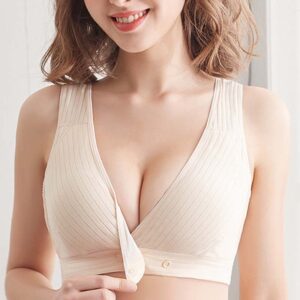
When selecting a nursing bra, there are several factors to consider to ensure the perfect fit and functionality. Here are the key factors to keep in mind:
-
- Size: Your breast size will change throughout pregnancy and breastfeeding, so it’s crucial to measure your breasts regularly and choose a nursing bra that accommodates these changes. Avoid purchasing nursing bras in advance, as it’s challenging to predict your postpartum size accurately.
- Support: Look for nursing bras that provide adequate support to prevent sagging and discomfort. Wide straps, a supportive band, and a secure closure are essential features to consider.
- Comfort: Look for nursing bras made from soft, breathable, and stretchy fabrics that feel comfortable against your skin. Avoid bras with rough seams or tags that can irritate sensitive breasts.
- Accessibility: Ensure the nursing bra you choose has easy-to-use flaps or clasps that allow for quick and hassle-free breastfeeding access. Practice opening and closing the flaps before purchasing to ensure they are easy to handle.
- Style: Nursing bras come in a variety of styles, from basic and practical to stylish and fashionable. Choose a style that makes you feel confident and suits your personal aesthetic. Remember, you can find nursing bras that combine style with functionality.
By considering these factors, you can find a nursing bra that not only meets your needs but also enhances your breastfeeding experience.
Sizing and Fitting Tips for Nursing Bras
Achieving the right fit for your nursing bra is crucial for comfort and support. Here are some sizing and fitting tips to ensure you find the perfect fit:
-
- Get measured: Visit a professional bra fitter or use an online sizing guide to accurately measure your bust and under bust size. Remember to measure while wearing a non-padded bra or without any clothing on your upper body.
- Consider your stage of pregnancy: If you’re purchasing nursing bras during pregnancy, choose a size that accommodates your expected postpartum breast size. Keep in mind that your breasts will increase in size after your milk comes in.
- Check the band size: The band of your nursing bra should fit snugly around your ribcage without digging into your skin. It should provide support without feeling too tight or restrictive.
- Adjustable straps: Look for nursing bras with adjustable straps to customize the fit according to your comfort level. Ensure the straps are not digging into your shoulders or slipping off.
- Trial and error: It may take some trial and error to find the perfect fit for your nursing bra. Don’t be discouraged if the first bra you try doesn’t feel right. Experiment with different brands and styles until you find the one that feels comfortable and supportive.
Remember, finding the right fit is essential for optimal comfort and support, so take the time to find a nursing bra that fits you perfectly.
Features to Look for in a Nursing Bra
To ensure your nursing bra meets all your needs, consider the following features:
-
- Easy-to-use flaps or clasps: The flaps or clasps on your nursing bra should be easy to open and close with one hand. This feature allows for quick and discreet breastfeeding access.
- Removable nursing pads: Nursing bras with removable pads or pockets for nursing pads help absorb any milk leakage and keep you dry and comfortable.
- Adjustable straps: Look for nursing bras with adjustable straps to customize the fit and provide additional support as needed.
- Stretchy fabrics: Nursing bras made from stretchy fabrics accommodate changes in breast size and shape, ensuring a comfortable fit throughout your breastfeeding journey.
- Supportive band: A wide and supportive band helps distribute the weight of your breasts evenly, reducing strain on your shoulders and back.
- Cup design: Nursing bras with cups that can be easily pulled down or unclipped for breastfeeding provide effortless access and ensure a secure fit when closed.
By considering these features, you can find a nursing bra that combines convenience, comfort, and functionality.
How to Care for your Nursing Bra
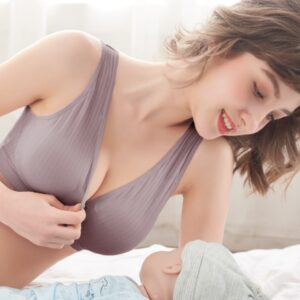
To ensure the longevity of your nursing bra and maintain its functionality, it’s essential to follow proper care instructions. Here are some tips for caring for your nursing bra:
-
- Hand washing: Hand washing is the gentlest way to clean your nursing bra. Use a mild detergent and lukewarm water, and gently massage the bra to remove any dirt or residue. Rinse thoroughly and lay flat to dry.
- Machine washing: If machine washing is necessary, use a lingerie bag and select a delicate cycle with cold water. Avoid using harsh detergents or bleach, as they can damage the fabric and affect the bra’s elasticity.
- Avoid tumble drying: Tumble drying can cause the bra to lose its shape and elasticity. Instead, lay the bra flat or hang it to air dry.
- Rotate your bras: To prolong the life of your nursing bras, rotate them regularly. This prevents excessive wear and tear and allows each bra to regain its shape and elasticity.
By following these care tips, you can ensure that your nursing bras remain in excellent condition throughout your breastfeeding journey.
Common Misconceptions about Nursing Bras
There are several misconceptions surrounding nursing bras that can lead new moms astray. Let’s debunk some of these myths:
-
- Myth: Nursing bras are uncomfortable: This myth is far from the truth. With the right fit and style, nursing bras can be just as comfortable as regular bras, if not more so. Look for nursing bras made from soft, stretchy fabrics that prioritize comfort.
- Myth: You only need one nursing bra: While it’s possible to get by with a single nursing bra, having multiple bras ensures that you always have a clean and dry bra available. It’s recommended to have at least three to four nursing bras in your rotation.
- Myth: Nursing bras are unattractive: Nursing bras have come a long way in terms of design and style. Many brands offer nursing bras that are both functional and fashionable, allowing you to feel confident and stylish while breastfeeding.
- Myth: You can’t wear underwire nursing bras: While it’s true that ill-fitting underwire bras can cause discomfort or clogged ducts, there are underwire nursing bras available that are designed to provide support without compromising comfort or breastfeeding access. Ensure you choose an underwire bra specifically designed for nursing.
By dispelling these misconceptions, you can make informed decisions and choose nursing bras that meet your expectations.
When purchasing a maternity bra here are some dos and don’ts for you to consider:
-
- When making your sale it is important to look for a maternity bra that provides excellent support and flexibility to allow for breast fluctuation. An easy way to check this is to slide your hand into the upper cup section to assess if there is enough room for expansion.
- When trying on different styles, remember to open and close the bra cup. Most bras are opened for feeding and some are easier to manage than others. Look for bras where the whole cup folds away, as opposed to rigid ‘trapdoor’ styles which can also put pressure on a full breast while feeding. One-handed maternity clips provide fuss-free release at feeding time.
- Ensure you buy a soft bra with six rows of hooks and eyes allowing for the diaphragm to expand during the months of pregnancy and the ability to tighten after the baby is born and the diaphragm settles. It also means you will be comfortable and have a supported silhouette!
- Power fabric panels will ensure extra support, especially at the breastfeeding stage as breasts become heavier.
- Underwire bras are not recommended during pregnancy and breastfeeding. Your breasts are changing shape and underwire bras may put pressure on the breast restricting milk flow which can cause blocked milk ducts or result in mastitis.
- Buy a bra with cups deigned to avoid the nipple area and therefore the risk of chafing. Seems that have stitching across the nipple area or unlined bras can cause irritation to already tender and sensitive breasts.
Don’t be lazy and leave it too late to get fitted for your breastfeeding bra. When you feel your bust increase in size, generally around the end of the first trimester, we recommend you visit a professional bra fitter. Depending on the development of your bust size you should be fitted again at approximately seven months, this bra, if fitted well should see you through to the end of your pregnancy and into the breastfeeding stage.
Conclusion: Find the Best Nursing Bra
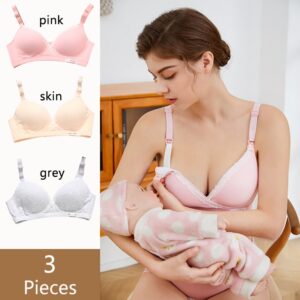
As a new mum, finding the perfect nursing bra is essential for a comfortable and successful breastfeeding journey. By considering factors such as fit, style, support, and functionality, you can choose a nursing bra that meets all your needs. Remember to prioritize comfort, accessibility, and proper fit when selecting a nursing bra.
Explore different brands and models to find the one that suits your preferences and lifestyle. Don’t be afraid to invest in multiple bras to ensure you always have a clean and dry one available. With the right nursing bra, you can breastfeed your little one with ease and confidence, knowing that you are providing them with the best start in life.
Congratulations on your new journey into motherhood, and may you find joy and fulfilment in every precious moment with your little one.
